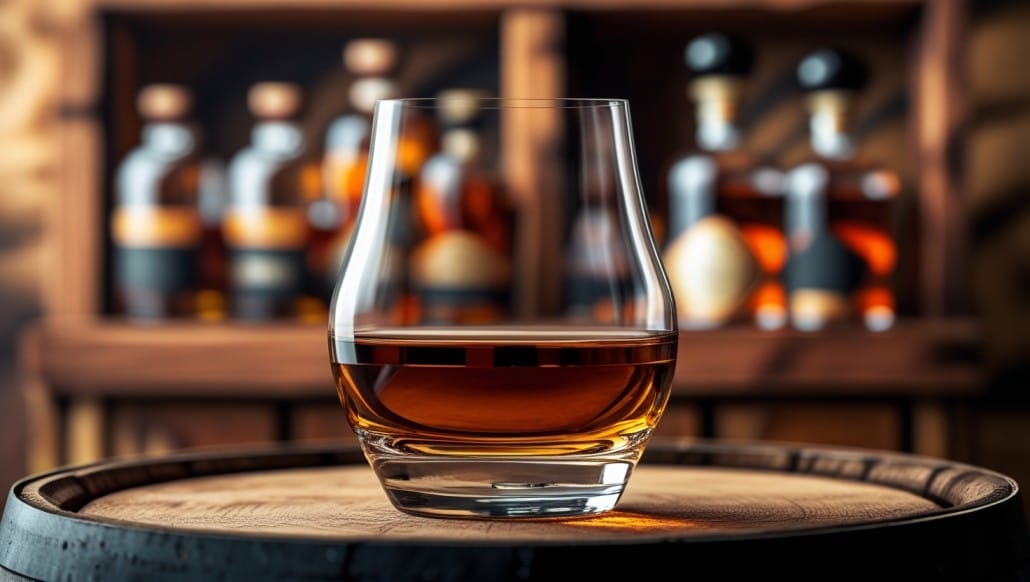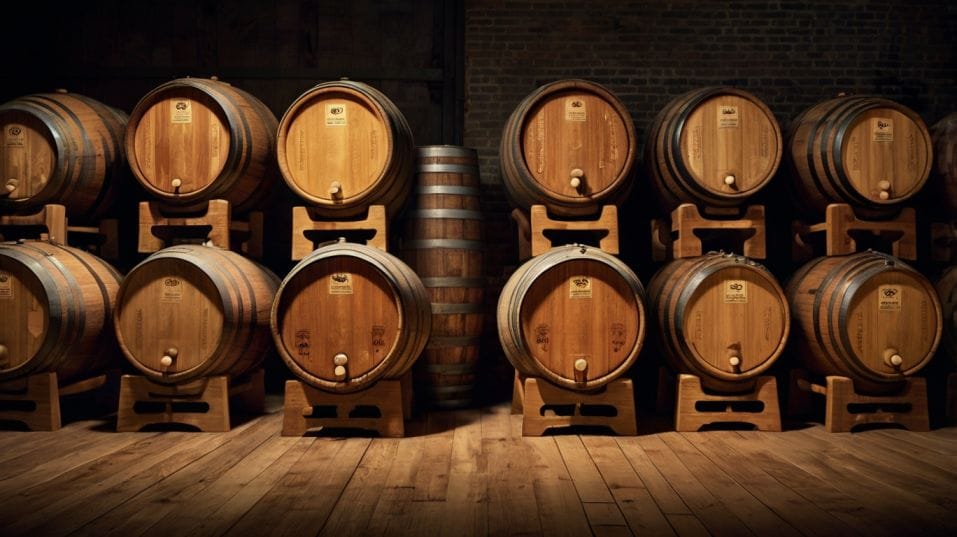How Barrel Type Shapes Whiskey Flavor
Discover how barrels shape whiskey flavor—from oak species to cask finishes—and learn to taste, choose, and collect with clarity and confidence.

What if the most important part of your whiskey isn’t what’s in the bottle—but what held it? For new whiskey drinkers, the barrel is often overlooked, yet it’s where raw spirit becomes rich character.
Once you start tasting for barrel influence, you unlock a whole new layer of understanding. Because to truly get whiskey, you have to get the wood.
The Barrel Is the Master Ingredient
Whiskey is made from grain, yeast, and water—but it’s the barrel that transforms it. Aging in wood doesn’t just mellow the spirit. It shapes its identity.
The moment new-make spirit enters the cask, a process begins that’s chemical, physical, and deeply sensory.
Over time, the whiskey seeps into the wood’s grain during warm temperatures, then contracts back out as it cools—breathing through the staves, extracting flavor, color, and texture.
And it’s not just about what goes into the whiskey. The charred interior of a barrel also acts as a filter, removing harsh compounds and smoothing out rough edges.
This dual action—infusion and filtration—is why the type of barrel matters so much.
New vs. Used: A Foundational Choice
In American whiskey, federal law requires the use of new, charred oak barrels. That one regulation alone defines the category’s flavor.
New oak is flavor-forward. It delivers powerful notes—vanilla, caramel, toffee, cinnamon, charred wood. It’s the reason bourbon often feels bold and sweet right out of the glass.
Used barrels, on the other hand, behave differently. In Scotch, Irish, and many world whiskies, second-fill (or third-fill) casks are common.

These barrels have already given up much of their heavy tannins and wood sugars, allowing the spirit’s grain character, fermentation nuance, and distillery style to shine through.
You’ll notice it in the glass. A single malt aged in a second-fill cask might taste lighter, drier, more restrained. You’ll pick up barley notes, honey, stone fruit, or even minerality—flavors that would be buried under heavy oak influence.
The Species of Oak: American vs. European
Not all oak trees are equal. The species of oak used to make barrels has a direct impact on whiskey flavor, and you’ll taste it once you know what to look for.
American Oak (Quercus alba)
Grown mainly in the U.S., this oak is relatively dense, rich in vanillin and lactones, and imparts sweet, smooth flavors: vanilla, coconut, caramel, and toasted nuts. It’s porous enough to allow solid interaction with the spirit without overwhelming it.
This is the backbone of bourbon, Tennessee whiskey, and often used in Scotch and world whiskies for a clean, approachable base.
European Oak (Quercus robur)
Denser and more tannic, European oak is common in Spain, France, and parts of Eastern Europe.
It delivers darker, spicier notes—dried fruit, leather, bitter chocolate, and baking spice. It’s frequently used in sherry casks, which brings us to one of the most transformative barrel techniques: cask finishing.
The Power of Finishing: Sherry, Port, Wine, Rum, and More
Finishing isn’t about disguising flaws. At its best, it’s about layering complexity.
Cask finishing involves transferring whiskey from its primary aging barrel into another cask that previously held something else—usually wine, fortified wine, or another spirit.
These secondary casks don’t just add flavor from the previous liquid. They also come from different oak species, with different toast levels and chemical makeups.
Sherry Casks (especially Oloroso and PX)
Spanish sherry casks—typically made of European oak—are rich with residual sugars and oxidized wine character.
An Oloroso cask might lend your whiskey notes of raisin, walnut, dark chocolate, or burnt orange. Pedro Ximénez (PX) casks push even sweeter—fig jam, prune, syrupy molasses.
Taste tip: If your whiskey smells like a holiday fruitcake or spiced fig, there’s a good chance a sherry cask was involved.
Port and Wine Casks
Port casks tend to bring red fruit, berry jam, and floral top notes. Red wine casks can be punchy—tannic, earthy, sometimes a little sour. Balance is key here. Overuse of wine casks can overwhelm the base whiskey, especially if the spirit is young.
Rum Casks
Rum finishes can be a wild card. A dry rum cask might add subtle tropical fruit, sugarcane, or estery funk. A sweet rum cask may bring out banana, brown sugar, or pineapple.
As a taster, don’t just hunt for these flavors—ask how well they integrate. A great finish doesn’t sit on top. It blends seamlessly, adding shape without stealing the spotlight.
Barrel Size and the Myth of “Faster” Aging
You’ll hear some distillers tout small barrels as a shortcut to faster aging. Don’t buy it blindly.
Yes, smaller barrels have more surface area relative to volume, so whiskey interacts with wood faster. But aging isn’t just about extraction—it’s about time, oxidation, and balance.
Small barrels can lead to over-oaked whiskey with harsh tannins, especially in hot climates. You might get flavor fast, but not necessarily flavor you want. A great whiskey is more than a wood bomb. It needs time to integrate, soften, and evolve.
Climate and Warehousing: Invisible Influencers
Barrel aging is a dance between whiskey and the environment. In warm regions like Kentucky or Texas, dramatic seasonal swings push whiskey in and out of the wood aggressively.
The result? Faster flavor uptake, often bolder, spicier profiles, with heavier oak signatures.
In cooler, wetter climates like Scotland or parts of Japan, aging is more gradual. The whiskey spends more time developing subtle character—delicate fruit, floral notes, layered complexity.
Oxidation works more slowly, and evaporation losses (“the angel’s share”) are lower.
Even inside a single warehouse, location matters. Barrels on upper floors of a rickhouse experience higher heat and more movement.
Bottom-floor casks age slower and cooler. Many distillers blend barrels from multiple warehouse zones to create balance.
How to Read the Barrel in Your Glass
You don’t need to be an expert to start tasting like one. Look at your whiskey through the lens of the barrel. As you sip, ask:
- Does the whiskey feel wood-forward or spirit-driven?
- Is the sweetness vanilla-caramel (new American oak) or dried-fruit-spice (European oak)?
- Are there wine-like notes (sherry, port, red wine) or tropical hints (rum)?
- Does the oak dry out the finish (tannin), or leave it lush and creamy?
Over time, you’ll start identifying barrel influence instinctively. You’ll notice when something is over-oaked, under-developed, or beautifully matured. And you’ll start building a collection with purpose, not just curiosity.
Final Thoughts: Start Tasting With Intent
Barrels are more than containers—they’re the engine room of flavor. Every detail matters: the species of oak, whether it’s new or used, what it previously held, the climate it aged in, and the warehouse it sat in.
Once you learn to taste for these details, you don’t just enjoy whiskey more—you understand it.
So take action. Pour two whiskeys side by side—one aged in new American oak, one finished in sherry. Taste the difference.
Write down what you notice. Build your palate, one dram at a time. This is how real whiskey knowledge is earned—not from trends, but from your own glass.
Pick your next bottle with purpose. Pour with curiosity. And let the barrel teach you something new.




